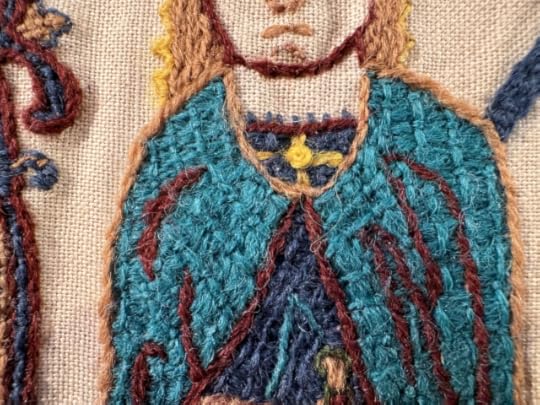Last night I did a book event at Village Books in Bellingham. It was a lovely event—but that’s not what I’m here to talk about today. One of those in audience (@Joi_the-artist on Xitter) brought me a marvellous piece of embroidery she’d made, interpreting the cover of Menewood into a Bayeux-style embroidery panel.
About the Embroidery
Here are some thoughts from Joi—and three of her photos.
Here are I picked Bayeux-style stitches because they existed in Anglo-Saxon needlework prior to the Tapestry, and it’s likely Hild would have known those stitches, or similar ones. The borders are stem stitch, which is still done today. It’s a stitch that creates bold edges without the gap between stitches that you get with straight stitch. Here are some stem stitch areas on the Tapestry.

The large color blocks are a distinctive Anglo-Saxon stitch that is no longer in use. It’s a shame: this method covers big areas quickly and gives a distinct, almost woven texture. It’s especially lovely for depicting cloth.

These stitches are worked by doing a satin stitch across the entire block of color. Then perpendicular lines are added at about 1cm intervals (usually the same color but not always.) This second set of lines is then couched down with tiny stitches.

I did use cotton cloth to stitch on, because it’s easier to work with than linen, but the thread is wool, which is accurate to the tapestry. I also tried to use colors that were in use on the Tapestry, rather than a modern palette.
@Joi_the_artist
When Joi says “couched down by tiny stitches” she really means tiny: you can barely see them. This whole panel is not quite 2cm wide.
 How many stitches on the head of a millimetre?
How many stitches on the head of a millimetre?It’s also wonderfully 3-dimensional.
 Just look at the colour and dimension in these stylised trees!
Just look at the colour and dimension in these stylised trees!This small panel represents a staggering amount of work and skill. Just imagine reaping the flax, retting it, scutching it, spinning it, bleaching it, weaving it. And that’s just for the base. Then for the woolen thread there’s shearing the sheep, washing the fleece, combing and carding, spinning, dyeing… Not to mention planting the plants, harvesting, treating etc to make the dyes. And don’t even think about digging the ore, smelting, and all the other million and one steps it would take to make the tools to make this one, 17 x 23 cm panel.
We are so used to just clicking on a link and having whatever we want drop-shipped to us overnight that those of us born in this time and place simply have no conception of the sheer work and skill and planning that even the simplest artifacts required in early seventh-century Britain.
Here are a few more photos of Joi’s art. First, the banners and falling arrows in miniature.
 You can even make out the boar…
You can even make out the boar…This one shows the cross and ragged detail at the collar.

And here’s the whole thing. My photo on this overcast Sunday morning does not do it justice.
 Textile art in seventh-century embroidery-on-linen style by Joi the artist: a stylised rendition of the cover of MENEWOOD (original art by Anna and Elena Balbusso) showing stylised trees to the left, banners to the right, a horse at lower right, with Hild standing on the word Menewood, tiny golden arrows falling from the sky and, above it all, Ecce Hild: Behold Hild.
Textile art in seventh-century embroidery-on-linen style by Joi the artist: a stylised rendition of the cover of MENEWOOD (original art by Anna and Elena Balbusso) showing stylised trees to the left, banners to the right, a horse at lower right, with Hild standing on the word Menewood, tiny golden arrows falling from the sky and, above it all, Ecce Hild: Behold Hild.
